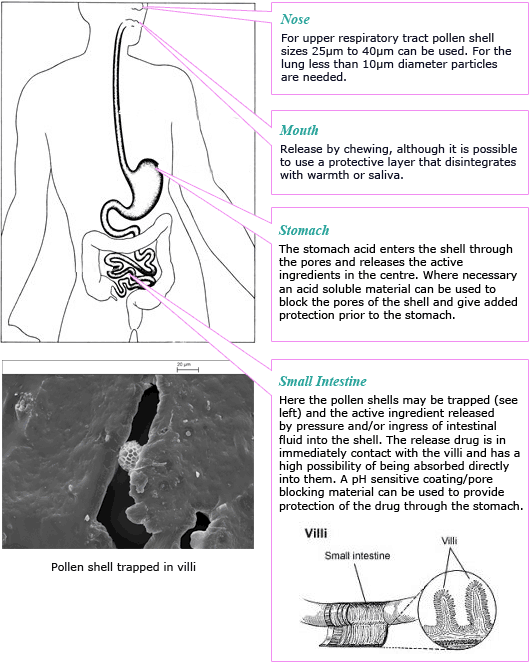Pharmacuticals
The ability to choose a single reproducible particle size according to the required application, is a major advantage of Sporomex® technology.
Figure 1 (click here) illustrates possible pollen exines for the main applications, although small particle sizes can be used for specialised topical applications and large ones for nasal deposition.
Topical
The two important factors tend to be the anti-oxidant protection of the shell coupled with the ability of the pressure from a finger or thumb to release an encapsulated ingredient onto the skin. The active ingredient is spread over the surface over a period of time by continued rubbing.
Although the larger particles may be advantageous in that they are able to contain more active material, small exine shells are able to penetrate into hair follicles. This could be used for hair restorers and may offer a novel method of administration for other drugs.
Oral/Buccal/Respiratory
For some drugs only the TASTE MASKING properties of the exine shells are required, whereas for others the anti-oxidant properties are also important (e.g. ferrous iron).
Common uses are illustrated:

For drugs that are not attacked by gut acids a simple encapsulation within the exine shell is normally all that is required. This can usually be carried out by physical means such as absorption or vacuum. The drug is not deliberately chemically attached, although this can be carried out if needed.
Where the drugs, e.g. peptide, vaccines, may be attacked by gut acids a co-encapsulant is required to block up the pores in the exine shell or provide a surrounding barrier.
Fats and starches can be used as co-encapsulants as can proprietary products such as Eudragit®. The latter can be especially useful for treatment of the lower gut, as the drug receives protection until it reaches this point.
For respiratory use, the major advantage of the Sporomex® technology is that all the shells of a particular species are the same size so it is possible to target a specific area of the lung. In addition they are natural, largely inert and protein free, (so are unable to give rise to allergies). In theory it is possible to take the spores causing a disease such as farmer’s lung, remove the genetic centre and refill the resulting shell with the antidote and inhaling the formulation. The spores would then be deposited at the correct location in the lung.
The exine shells are very easily dispersed and can be taken with a nebuliser or breathed in as snuff. Small ones, such as those from Aspergillus niger (4 µm) are able to penetrate deeply into to the lungs. Larger ones can be deposited into the larger airways or nose.
Unlike oral treatment the exine shells are not in contact with acids so co-encapsulation is not normally needed. The porous nature of the exine shell enables the active ingredient to be released into the lung or nose. If required exine shells with larger holes can be used to give quicker release.
Exine shells may be used for the protection and oral delivery of acid sensitive peptide drugs and antibodies and for the oral or respiratory delivery of vaccines.